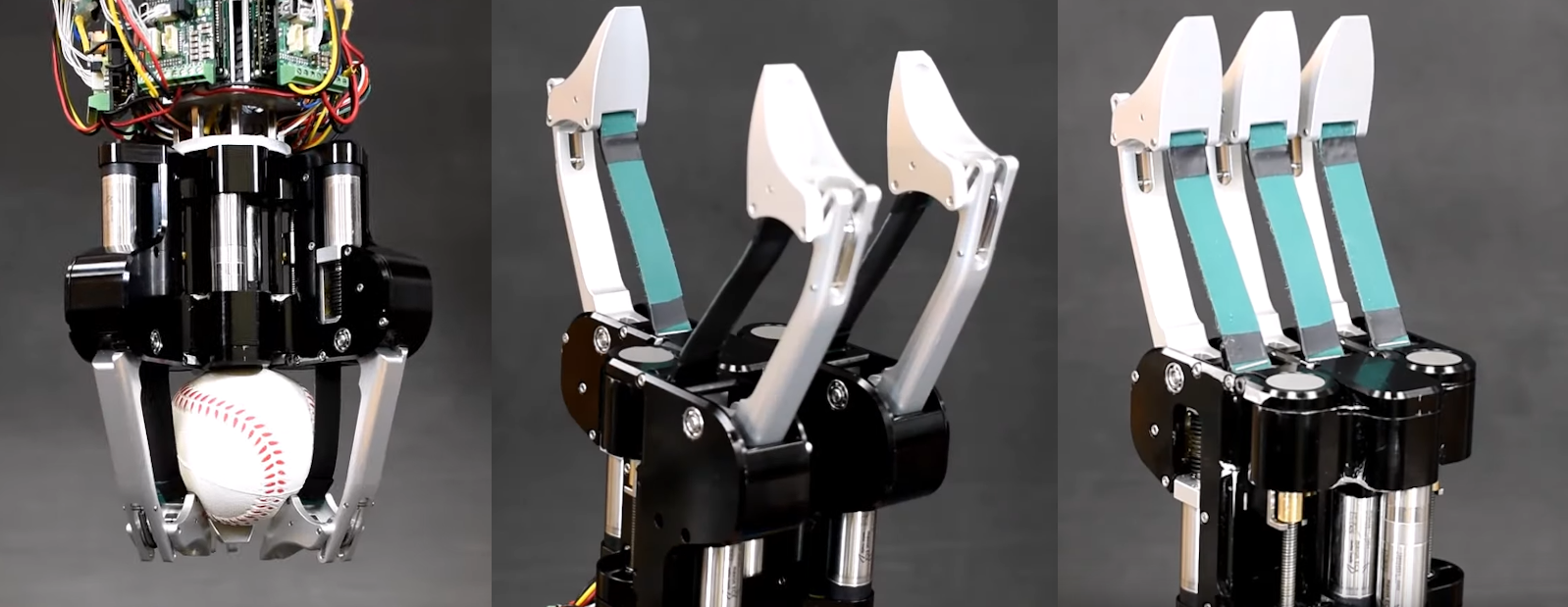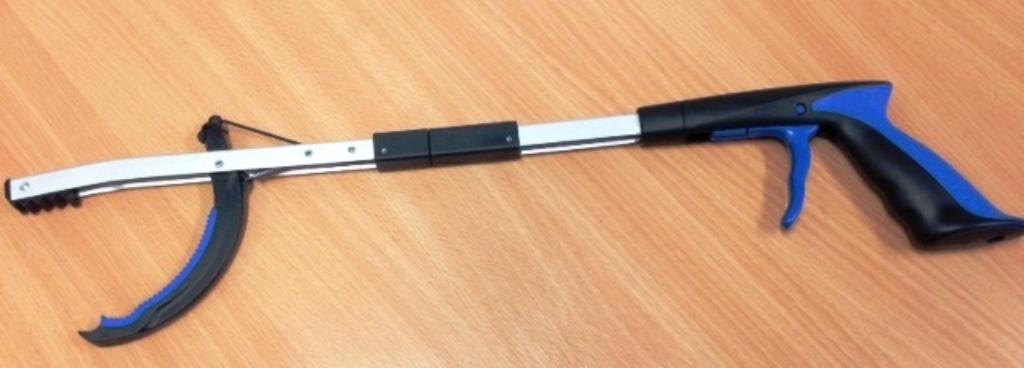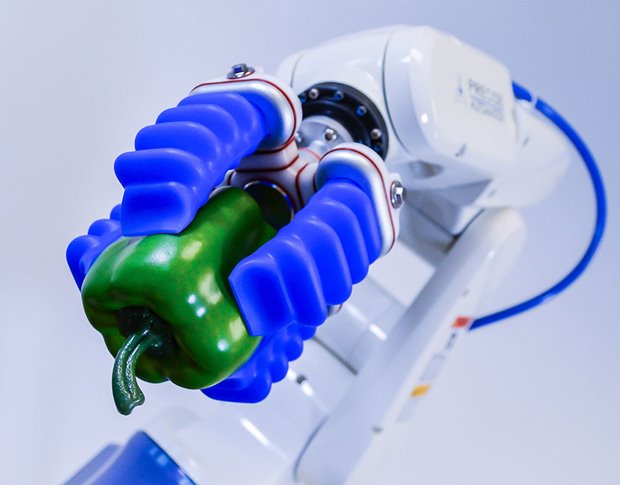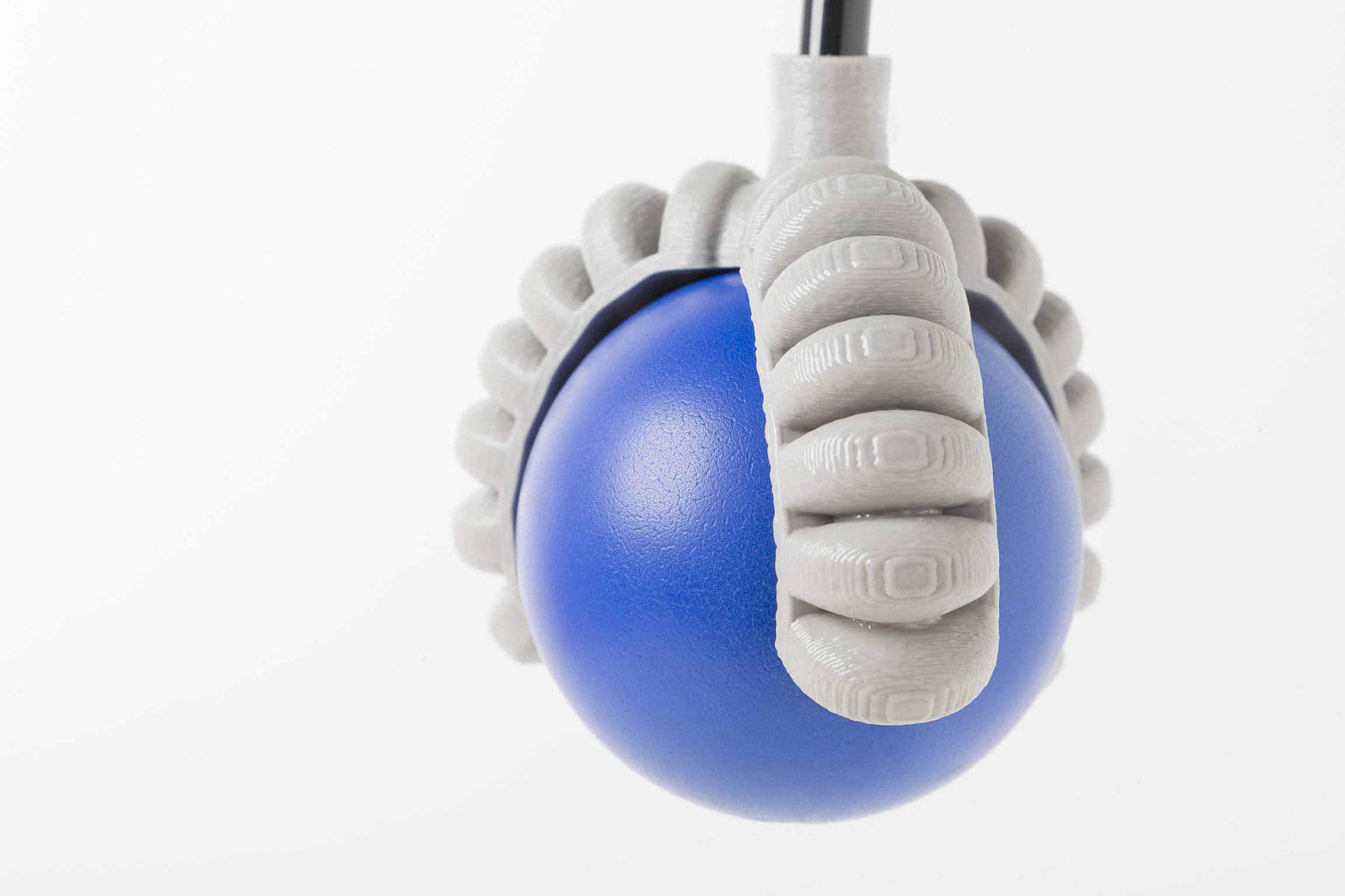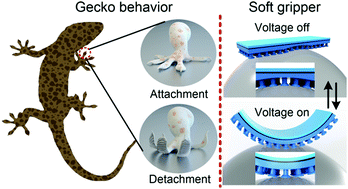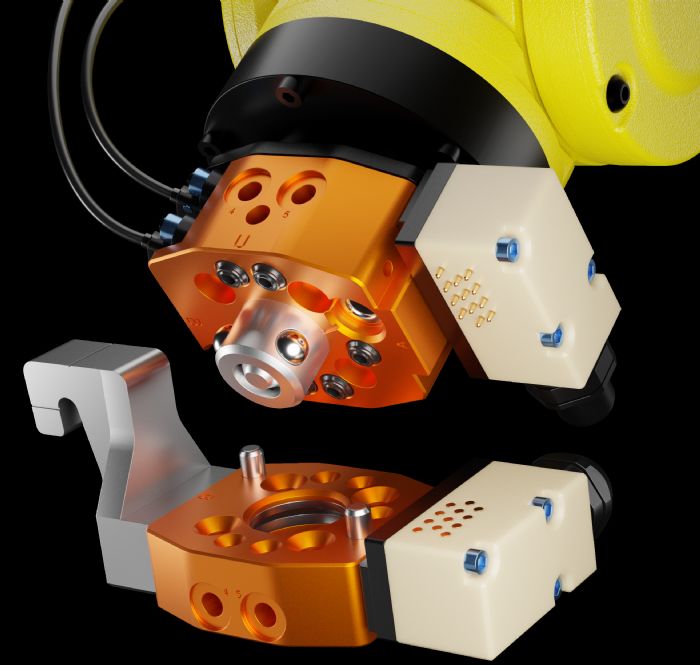End Effector Research
Industry and team examples
- note that DOF in gripper does not include the rotation of the gripper, that is an arm dof
| Team | Year | SAR Score | Extreme Retrival Score | Equipment Servicing Mission | Picture | Number of Fingers in gripper | DOF in end effector | Allen Key feature | Other comments |
|---|---|---|---|---|---|---|---|---|---|
Ryerson Rams Robotics | 2019 | 90 | 77 | 4 | 1 | Not apparent | 4 fingers make it easy to grab rocks They are lacking strength in the wrist | ||
| IMPULS | 2019 | 80 | 69 | 2 | 1 | Not apparent | Very rigid stiff | ||
| PCz Rover Team | 2019 | 80 | 42 | 2 | 1 | Not apparent | Interchangeable end nubs | ||
| Stanford Student Robotics | 2019 | 64 | 57 | 2 | 1 | Not apparent | rubber band in v grove for compliance. | ||
| Michigan Mars Rover Team | 2019 | 32 | 54.5 | 2 - one fixed | 1 | Not apparent | no compliance? - didn't score well for extreme retrieval. perhaps it is correlated Arm is very interesting, no fancy links just direct drive through a gearbox. Not very aesthetic though. | ||
| Michigan Mars Rover Team | 2020 | 96 | 2 | 2 | Allen key has its own lead screw on the outside of the claw. Might be off center of rotation | No slip ring wires allow a certain number of twists Wire management is also kinda a mess on this bot. | |||
| Stanford Student Robotics | 2020 | 94 | 2 | 1 | Allen key coupled with the central lead screw that controls the jaws | Wrist looks like it has no slip ring. Jaws fold back, exposing the allen key, and the axis 6 screws in the screw. Looks like a coaxial axle is used to control both axis 6 and the jaws. They have a very good design. | |||
| BRACU University Mongol-Tori | 2020 | 93 | 2 shovels | 1 | Not apparent | Chain driven axis 6 is interesting. piston rod driven gripper is also interesting. Allows for axis six to 'wrap around' it without any issues. A sort of mechanical slip ring. | |||
| Missouri S&T Mars Rover Design team | 2020 | 93 | 2 spring loaded | 1 | Opposite side of the differential. Looks like it has multiple tooling bits! | gripper looks like it only half works, as one complies fully and the other does not. 2 cameras for each tool which doubles the expense there. Nice small cameras though. | |||
| Mars Rover Manipal | 2020 | 92 | 2 | 2 | Differential wrist with isolated Allen key with its own motor. | Very simple and cheap good design. Very epic CAD render transitions | |||
| Team Anveshak | 2020 | 91 | 2 | 2 | Allen Key is 90° from the claw and has its own motor | A nice compliant mechanism Very good claw. Love the Erasers. |
Additional Notes:
From other teams it seems strength of gripper is the biggest contributor to performance. the great variation in grippers also suggests also that the performance in each mission is heavily dependent on the performance of the arm and control system. This can be seen from IMPULS' very simple digit claw that has no compliance. compared to Michigan though, they have a cup shape grove which may help slightly
A lot of good teams, also have solenoids to trigger keyboard keys. this way the alignment can be done before hand without relying on dynamic precision.
Also note that no one uses slip rings! Also note that no one uses coaxial transmission shafts. It might be too difficult to design/too difficult to manufacture or just decided to go direct with the motor. None of these designs look very aesthetic, except for maybe Stanford, but that's my opinion.
End Effector
This is the claw, tool bit and key stroke pusher rolled into one. It is used to grip items in retrieval missions, turn cap screws with a hex drive feature, and push keys on a keyboard. Previously, our team has used an square end Allen key to turn the cap screw as well as push the keys. Some teams use a solenoid to push keys.
Ball-nose tool tip for a looser accuracy requirement
List of Interact-able Items
Below is a list of items we may have to interact with at comp, sorted by mission. This will give us a better idea of what we need to grip:
Extreme Retrieval and Delivery
NOTE: ALL ITEMS WILL BE NO GREATER THAN 5CM IN DIAMETER
- screwdriver
- hammer
- wrench
- Toolbox
- Gasoline Can
- Pick up and transport rocks up to 5kg in mass
- Tow rope (15mm diameter max) with a 5kg weight
Equipment Servicing
- Cache container (< 3kg) with a 10cm handle (min) with a 5cm diameter (max)
- Handle drawer
- Socket head cap screw
- Undo a latch on hinged panel, and open panel
- Type on Keyboard
- Operate a joystick to direct an antenna while observing a guage
- Pick up and insert a rugged USB memory stick into a USB slot
- Push buttons, flip switches, turn knobs
- Water bottle and other cylindrical items
Science
- Scoop dirt (if we roll science functionality into arm)
Pneumatics
Side note before starting! At my co-op we use a lot of pneumatic cylinders so I might be suffering from design fixation!
This idea is to replace the actuator, gears and lead-screws with 2 air cylinders filled with hydraulic fluid to actuate the the claw. One cylinder with be the driver, located on the chassis which is controlled with a linear actuator, and the other on the arm is driven to control the gripper. The inspiration comes from industrial robotic arms with gripper end effectors, you'll notice that all of them use pneumatics or hydraulics. The reason they do this is because they are small, compact and offer a lot of force when compared with an electric actuator. Using a cylinder allows us more space at the wrist and more importantly makes the arm lighter. One thing cylinders lack is precision, good thing we don't need it for a gripper! cylinders can sill be precise, but not comparable to high end linear actuators. That being said, typically we use a lot of gearing to achieve the correct torque in the claw. which means the tolerance stack-up after the gearing is probably very similar to that of a hydraulic cylinder.
I propose we use a large bore, small stroke pneumatic cylinder filled with hydraulic fluid.This is possible, only that we have to use the same maximum pressure rated for that air cylinder. Even then we will not reach those pressures for our application. More calculations will need to be done before deciding if this idea is even practical but it is worth more thought.
Potential suppliers are SMC or Festo.
The current idea pneumatic diagram is shown below. Here is a link to the symbol cheat sheet https://blog.utp.edu.co/ricosta/files/2011/08/SIMBOLOGIA-NEUMATICA-ISO-1219-1.pdf
There should be some feature to vent air out of the lines, and a feature to top up oil. But this can be explored in detail after the idea is moved further.
There are some potential issues with this system, some of which can be accounted for now, and some not, due to the teams lack of familiarity with air/hydraulic cylinders. Following will be a list of pros and cons of attempting this design.
| Pros | Cons |
|---|---|
| Far more force compared to electrical | All cylinders do leak slowly over time, might be negligible at low pressures |
| Less moving parts on the arm | just moving the actuator to a different spot, the linear actuator is never removed, just moved to a more convenient location (the base) |
| smaller end effector | figure out how to route hydraulic lines instead of electrical lines. |
| lighter end effector | lack of familiarity |
| Great opportunity to learn | have to deal with hydraulic fluid/or another oil |
| Cost effective (gears mainly) | might be a pain in the ass to wire up (tube up?) |
| Closed loop (with current concept) | |
| No need for pneumatic control (closed loop) therefor same linear actuator for control |
Gripper Material
A good gripper material should be able to easily grasp any item with the least amount of force to do so.
Low friction means higher grip strength to restrain the item. With low material compliance means less surface area contact, which means more strength required to hold the item and a higher chance of mis-grabs. From these statements it appears apparent to choose a material with a high coefficient of friction which is highly compliant.
Also note that if the gripper is able to wrap around the part to a certain degree, the holding force will not be 100% the normal force (which is good!) this means with higher wrap, less force is required to to squeeze the claw.
https://www.youtube.com/watch?v=Oj9fwv6BcUM
Human skin is around 10A, foot insole gel is around 30A, car tire is around 50A. Bars of urethane rubber can be found on McMaster-Carr for a good price, the softest material being ~40A but we can fabricate our own using silicon if need be. These Rubber bars can be cut with a water-jet but tolerancing might be iffy. 3D printing is also an option. 3D printing can be comparable in price or more expensive, whilst giving unique challenged that take a lot of time to tune. this is not something I am particularly interested or knowledgeable about so if anyone has any words on the subject please feel free to comment.
Number of fingers
Most other teams use 2 fingers. 2 fingers can easily complete all the tasks. Adding more fingers without adding more degrees of finger freedom will hinder the ability to pick up certain objects, for example trying to pick up a cylinder with 3 equally spaced fingers. The mechanical design is also further complicated with more fingers, so will not be considered further. 2 fingers is perfectly find, its what everyone else does and its what industry does.
that being said there are some very cool multi-finger end effectors out there, which are very complex. This is something can be considered for next year though as this gripper alone is 6dof.
Allen key-less?
There are no rules that state an allen key must be used, just that there will be a fastener to tighten. Ever have the incorrect allen key and resort to using a vice grip? that is the idea. Make the gripper extremely strong and use the tip to pinch the fastener in order to twist it. Advantage is you do not require as much precision to align the gripper compared with a key. Also reduces the complexity of the end effector. Disadvantage is the gripper has to be very strong (refer to pneumatic section for strength) and if the fastener is countersunk or counter-bored we will be fucked.
Contact surface geometry
In industrial applications it is predictable what is being picked up so specific small scope grippers are designed and used. For our application, the gripper will have to pick up a wide range of items. This means the gripper should be compliant to a wide range of items. A commercial item that does this are garbage grabbers. Human fingers are also very dynamic at the tasks they can do.
The purpose of this heading is to consider the rubber material shape/placement and its backing to provide compliance.
One problem with these trinkets is that they can be pretty crappy with tolerance and/or grip strength (weak linkage, cheap plastic) but they can pick up everything small and light.
Something to note, is that smaller components generally required less compliance to pickup, for example the shank of a screw driver. and larger items require more compliance, such as a large rock or cylindrical bottle. This is similar to your hand. The palm of your hand is nice and squishy with lots of flex, the fingers have soft grip but are backed by stiff bones, and then at the top is a hard fingernail. We can create a composite claw with stiff carbide inserts at the tips and soft flexible rubber in the throat of the claw to accept cylinders.
< carbide insert
A few teams do this. Others skip the soft squishy insides and just go for rigid tips.
< This team struggles (slightly) to properly position the can due to freedom in the throat of the gripper.
Flexture design
Very nice compliant rubberized gripper from BYU
This looks like it is rubber dipped 3d printed plastic, very interesting concept from Binghamton University
Tool Torque
Tighten captive screw to secure drawer. Screw will be a 5/16”Allen (hex)head.
Assuming elbow rotates*
A 5/16" Allen key is used to drive a 3/8" socket head screw. A 3/8" UNF socket head screw requires 26 ft lbs. (35.25 Nm). This is more torque than required for the forearm to hold a 5kg at 90° (including wrist weight) extended 25 cm out accelerating upwards at 1G.
this is worst case scenario below.
< crude calculations
Gripper torque
https://www.redwoodplastics.com/wp-content/uploads/2019/03/Urethane-2019.pdf
This is very encouraging, but for the sake of calculation we will assume a coefficient of friction, between the contact pads and what we are gripping as 0.65, as sources very. It will also be assumed we have a bad grip on the object (IE without friction the part would slip out, not cupped)
Mechanical geometry
This pertains to the 2 finger end effectors.
This is what I define as the path the jaws take during the open close cycle. There are several different types used in competition. Each with subtle advantages and disadvantages relating to the effectiveness, ease of design, cost of design and number of parts.
some aditional notes can be found here: https://en.wikipedia.org/wiki/Four-bar_linkage
| Linkage Type | Image | Notes | Jaw Parallelism |
|---|---|---|---|
| Geared Parollelogram linkage | This is what we have (instead of gears it is leadscrew) note the outward extension of the tips vary during the stroke | Jaws Stay Parallel | |
| Central Piston | This could be a lead screw or other Nice because it is symmetrical Also nice because it is gearless This could be mixed with the parallelogram | Positive angular separation at open | |
| Linear Slide | No outward extension during stroke May increase the cost due to the need of linear slides | Jaws Stay Parallel |
More possible actuator types
Soft grippers
seem to be good for surface level light, round objects. not so much for buried objects which are heavy.
jamming phase transition gripper
Seems to janky and flexible to get working right. Also required a fluid such as air to operate. Also does not seem viable for heavy or burried objects.
< maybe heavy objects?
gecko grippers
https://all3dp.com/soft-robotic-gripper-with-gecko-inspired-adhesives/
https://www.youtube.com/watch?v=vpTX32KdVBQ
These pads bay be feasible to create with a fresnel lense as a mold and silicone as the gripper material which can be stuck on the existing gripper. Thought emporium has a well documented video on this. Many use this with soft robots, but this can also be used as a 'glove' on the existing claw.
Tool changing.
This could be if we have mutiple different grippers, or a gripper and a allen key, or a hook, etc.
+ It would decrease the complexity of the singular end effector
- increase the complexity of the wrist mount point.
- Have to worry about clean contacts (if the end effector was electrically controlled)
+ Great opportunity to learn
+ Lighter arm
- Heavier overall mechanism
















